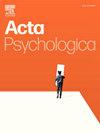Mechanism behind overestimating the duration of fearful expressions: The role of arousal and memory
IF 2.1
4区 心理学
Q2 PSYCHOLOGY, EXPERIMENTAL
引用次数: 0
Abstract
Background
Previous studies have demonstrated that individuals overestimate the time duration of fear-related stimuli compared with relatively neutral stimuli. However, their physiological and psychological mechanisms behind this effect remain unclear. This study investigates the overestimation the duration perception of fearful faces and its relationship with general cognitive ability (short-term memory, working memory, and attentional inhibition).
Method
Emotional pictures were selected from the Chinese Facial Affective Picture System. A total of 85 university students (43 females and 42 males,aged 20–24 years) participated in the experiments at a university. In Experiment 1,a temporal bisection task (300 ms: 1200 ms) was used to explore the effect of perceptual overestimating the duration perception of fearful faces and its relationship with general cognitive abilities (short-term memory, working memory, and attentional inhibition), In Experiment 2, the short and long standard time intervals were set to 1200 ms and 4800 ms, respectively, with the other conditions remaining the same as in Experiment 1.
Results
Both experiment revealed that participants overestimated the duration of fearful faces compared with that of neutral faces. Experiment 1 indicated no significant correlation between short-term memory, working memory, attention inhibition tests, and the overestimation effect. Experiment 2 revealed a positive correlation between working memory test scores, short-term memory test scores, and the overestimation effect,as well as temporal sensitivity.
Conclusion
Individuals tend to overestimate the duration of fearful faces, and the influence of arousal and memory is modulated by the length of the target time intervals.
高估恐惧表情持续时间的机制:唤醒和记忆的作用
背景以往的研究表明,与相对中性的刺激相比,个体会高估与恐惧相关刺激的持续时间。然而,这种效应背后的生理和心理机制仍不清楚。本研究探讨了高估恐惧面孔持续时间感知及其与一般认知能力(短时记忆、工作记忆和注意抑制)的关系。共有 85 名大学生(女 43 人,男 42 人,年龄在 20-24 岁之间)参加了实验。在实验1中,我们采用了时间分段任务(300 ms:1200 ms)来探讨被试高估恐惧面孔持续时间感知的影响及其与一般认知能力(短时记忆、工作记忆和注意抑制)的关系。在实验2中,短标准时间间隔和长标准时间间隔分别设置为1200 ms和4800 ms,其他条件与实验1相同。实验 1 表明,短时记忆、工作记忆、注意抑制测试与高估效应之间没有明显的相关性。实验 2 表明,工作记忆测试得分、短期记忆测试得分和高估效应以及时间敏感性之间存在正相关。
本文章由计算机程序翻译,如有差异,请以英文原文为准。
求助全文
约1分钟内获得全文
求助全文
来源期刊

Acta Psychologica
PSYCHOLOGY, EXPERIMENTAL-
CiteScore
3.00
自引率
5.60%
发文量
274
审稿时长
36 weeks
期刊介绍:
Acta Psychologica publishes original articles and extended reviews on selected books in any area of experimental psychology. The focus of the Journal is on empirical studies and evaluative review articles that increase the theoretical understanding of human capabilities.
 求助内容:
求助内容: 应助结果提醒方式:
应助结果提醒方式:


